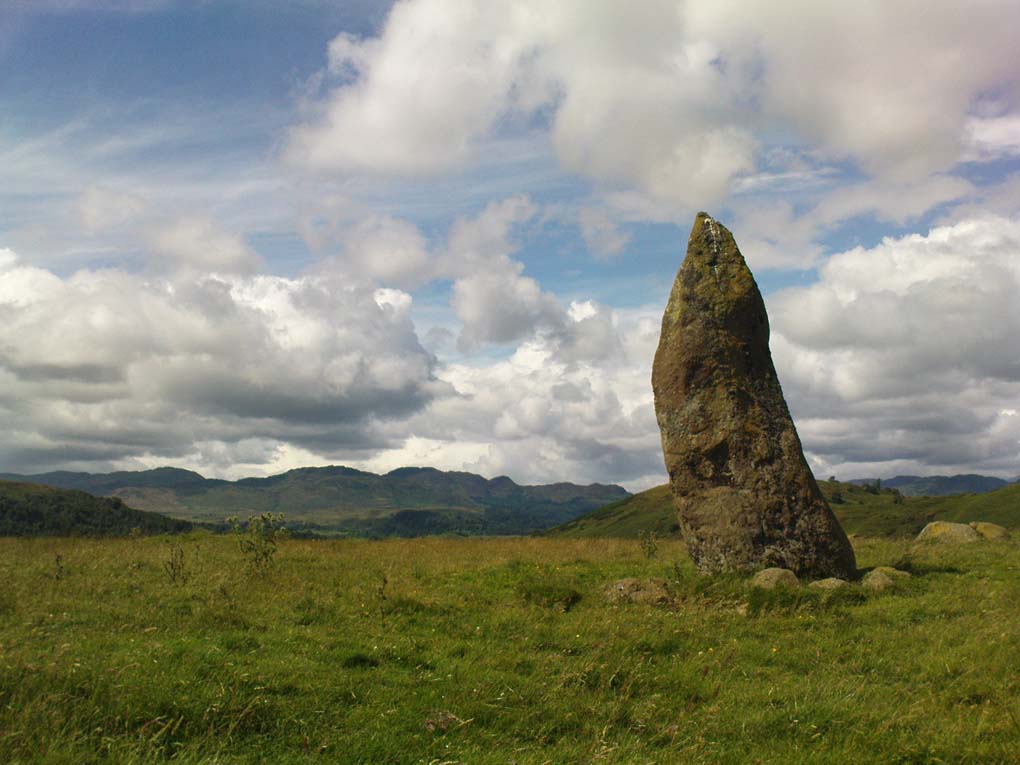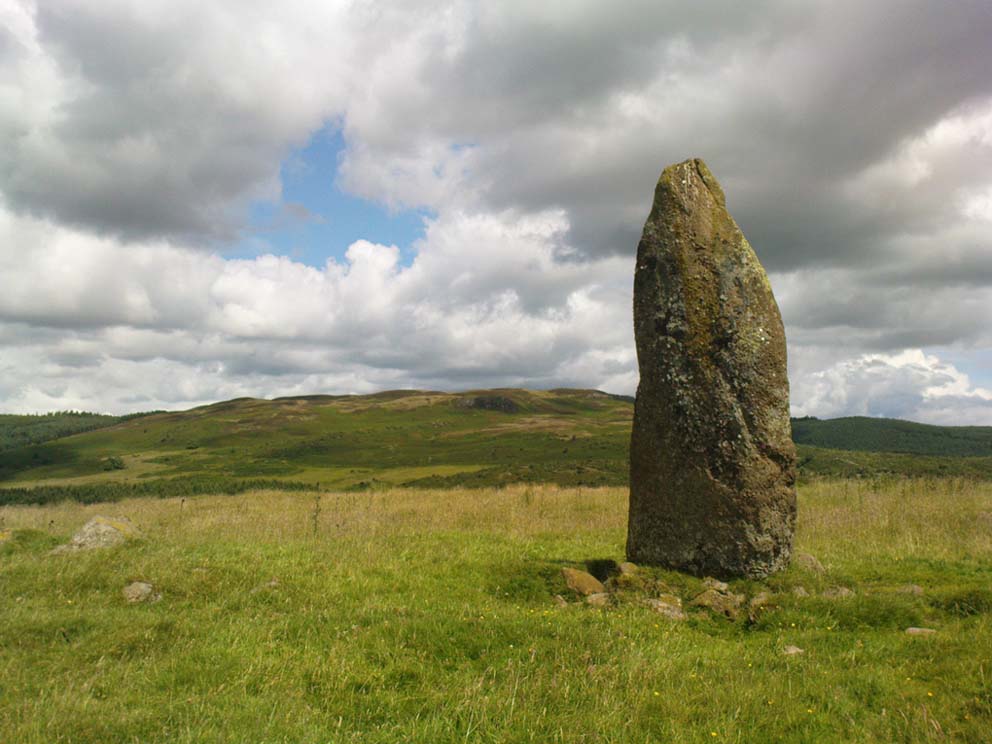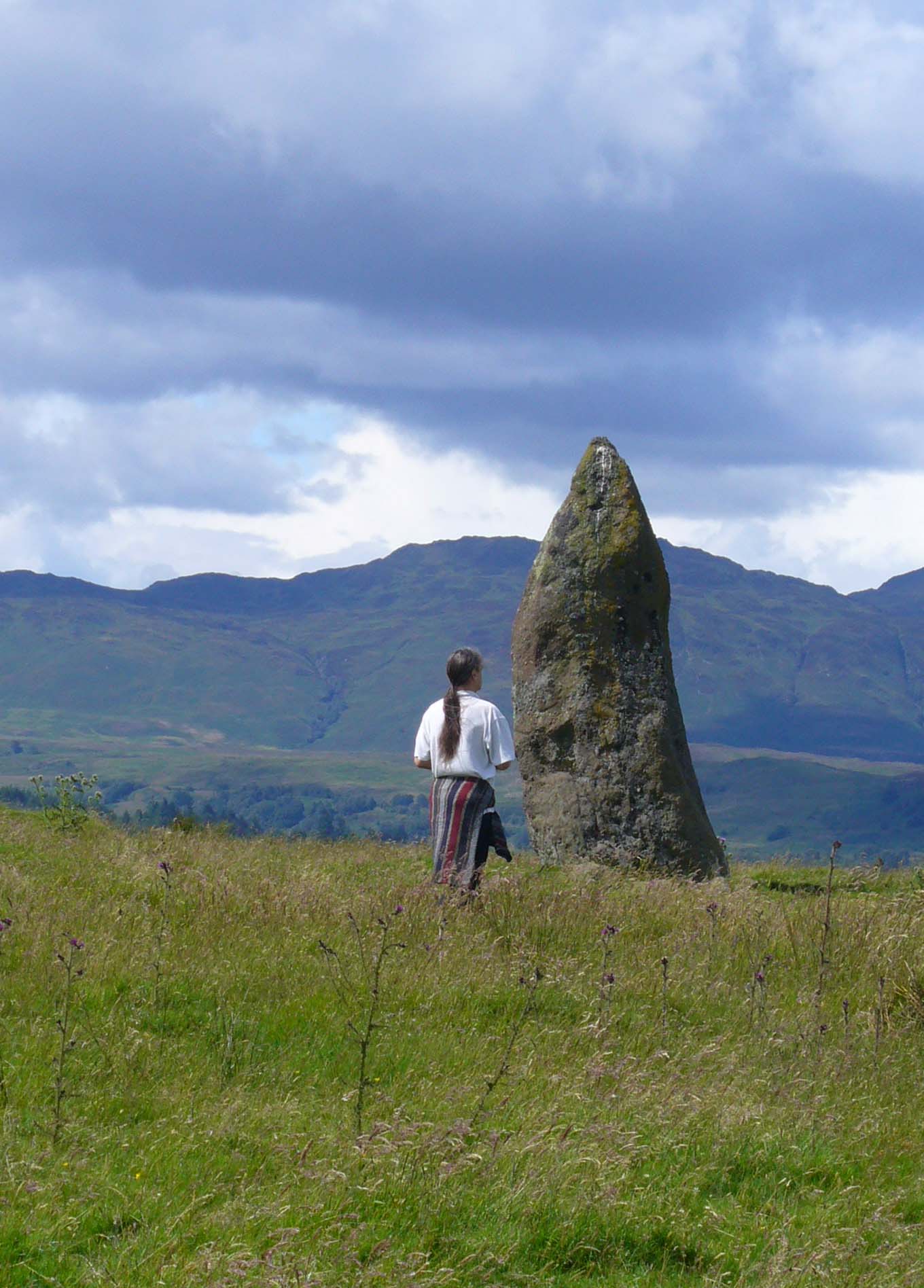Standing Stone: OS Grid Reference – NN 79555 17388
Also Known as:
- Aodann Mhor
- Cornoch
- Shillinghill

From Comrie town centre take the road south across Dalginross Bridge over the river, heading towards Braco, up the winding B827 road for 2-3 miles until you reach a small crossroads (you can easily miss it, so watch out!). Turn left and, about a mile on, 100 yards or so before Craigneich Farm (near its lovely standing stone), go up the track on your right up the hills. Follow the track up and through the gate, then walk straight uphill. A coupla hundred yards up you’ll see a large standing stone on the flat grassy plain to your left. That’s Dunruchan A.
Archaeology & History

This is a magnificent stone in a magnificent landscape, no doubt of considerable mythic importance to the people who lived and erected it several thousand years ago. It is the tallest of at least six standing stones to be seen on this section of moorland and stands out on the hillside from various angles as you walk the hills and glens around here: an element that was, no doubt, intended by those who built it. It’s probably a very old standing stone, more likely neolithic in origin than the generally ascribed Bronze Age.


Standing on the flat grassy plain above Shillinghill and Craigneich, it is surrounded by many small cairns and, it would seem, was once accompanied by a cairn of its own if the scatter of small rocks around its base is anything to go by (though I’m not aware of any detailed excavations here by antiquarians, so this initial assumption may be wrong). Indeed, it seems the Dunruchan A stone stands in the middle of a scattered prehistoric cemetery if the many small overgrown piles of rocks are anything to go by: though I know of no detailed account of these many scatterings of stones (anyone know if they’re ancient, or field clearances?). However, the great megalith hunter Fred Coles (1911) did comment on how this and the other giant standing stones nearby may “commemorate burials,” but didn’t explore the idea any further.
Approaching twelve feet tall, it was Cole (1911) who described this huge standing stone in one of his essays on the Perthshire megaliths, telling:
“Dunruchan Moor stretches, at a general height of about 700 feet above sea-level, for nearly two miles towards the south and south-west of Craigneich. At its northern extremity, and distant from the Craigneich Stone about 610 yards, stands the first and the tallest of the group (A on the plan), a huge pointed mass of conglomerate schist, its apex being 11 feet 4 inches above ground. Its base is a somewhat regular oblong, measuring along the north and south faces 4 feet 2 inches, and across the edges 3 feet 10 inches and 2 feet 2 inches, the wider of these being on the east. Small and insignificant boulders lie loosely around it. The smoothest and most vertical side faces the north. The illustration (fig. 16A) was drawn from the east, with the Aberuchil Hills as a background.”

From this great stone, looking west across the moors the giant standing stone of Dunruchan C and its companions can be noticed just a few hundred yards away. A cup-marked stone can also be seen about 200 yards west of here. It has been suggested that this and the other standing stones were part of some curious megalithic stone row (Burl 1993; Thom 1990), but this seems most unlikely. Thom made no notes of the archaeoastronomical potential at Dunruchan A, nor its associates.
As a megalithic complex, this area is outstanding. The other large standing stones of Dunruchan D and Dunruchan E are on the moorland plain a few hundred yards to the southwest and must be visited if you explore the area. This is serious megalith country!
Folklore
According to an account in the Ordnance Survey Name Book of 1860, “these stones are believed to mark the graves or commemorate the death of Roman soldiers who fell in a battle fought here between the Romans and the Caledonians.”
References:
- Burl, Aubrey, From Carnac to Callanish, Yale University Press 1993.
- Cole, Fred, “Report on Stone Circles in Perthshire, Principally Strathearn,” in Proceedings of the Society of Antiquaries, Scotland, volume 45, 1911.
- Finlayson, Andrew, The Stones of Strathearn, One Tree Island: Comrie 2010.
- Hunter, John, Chronicles of Strathearn, David Phillips: Crieff 1896.
- Thom, A., Thom, A.S. & Burl, Aubrey, Stone Rows and Standing Stones – 2 volumes, BAR: Oxford 1990.
ACKNOWLEDGEMENTS: Many thanks to Paul Hornby for use of his photos!
© Paul Bennett, The Northern Antiquarian
Love your great stone in the sky shot 🙂